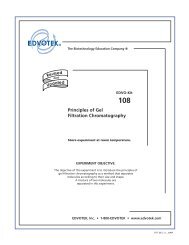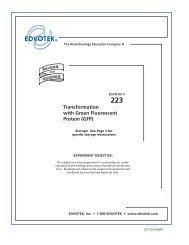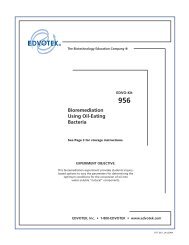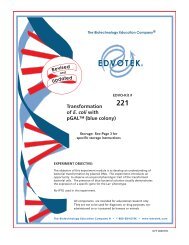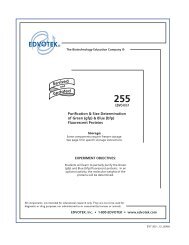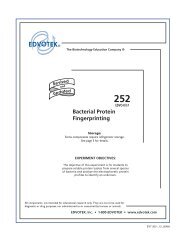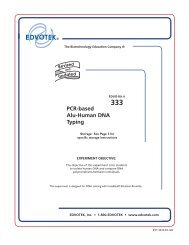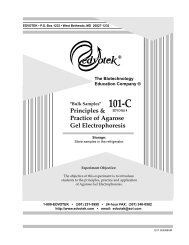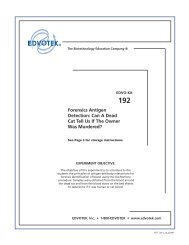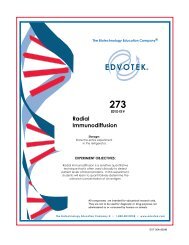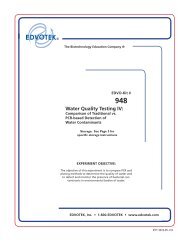953 - EDVOTEK
953 - EDVOTEK
953 - EDVOTEK
You also want an ePaper? Increase the reach of your titles
YUMPU automatically turns print PDFs into web optimized ePapers that Google loves.
14<br />
EDVO-Kit #<br />
<strong>953</strong><br />
Water Quality Testing III: Multiplex PCR Analysis for Water Contaminants<br />
Module III: Separation of PCR Reactions by Agarose Gel Electrophoresis<br />
The Experiment<br />
If you are unfamiliar<br />
with agarose gel<br />
preparation and<br />
electrophoresis,<br />
detailed instructions<br />
and helpful resources<br />
are available at<br />
www.edvotek.com<br />
Agarose Gel Requirements<br />
• Recommended gel size: 7 x 14 cm<br />
7 x 14 cm gels are recommended to achieve better resolution of the PCR<br />
products. Each gel can be shared by several students or groups.<br />
• Placement of well-former template: first set of notches<br />
• Agarose gel concentration: 1.0%<br />
Preparing the AGAROSE GEL<br />
1. Close off the open ends of a clean and dry gel bed (casting tray) by using<br />
rubber dams or tape.<br />
2. Place a well-former template (comb) in the first set of notches at the end<br />
of the bed. Make sure the comb sits firmly and evenly across the bed.<br />
Important Note<br />
Continue heating until the<br />
final solution appears clear<br />
(like water) without any undissolved<br />
particles. Check<br />
the solution carefully. If you<br />
see "crystal" particles, the<br />
agarose is not completely<br />
dissolved.<br />
3. To a 250 ml flask or beaker, add agarose powder and buffer as indicated<br />
in the Reference Tables (Appendix A) provided by your instructor. Swirl<br />
the mixture to disperse clumps of agarose powder.<br />
4. With a marking pen, indicate the level of the solution volume on the<br />
outside of the flask.<br />
5. Heat the mixture using a microwave oven or burner to dissolve the agarose<br />
powder.<br />
6. Cool the agarose solution to 60°C with careful swirling to promote even<br />
dissipation of heat. If detectable evaporation has occurred, add distilled<br />
water to bring the solution up to the original volume marked in step 4.<br />
After the gel is cooled to 60°C:<br />
7. Place the bed on a level surface and pour the cooled agarose solution<br />
into the bed.<br />
8. Allow the gel to completely solidify. It will become firm and cool to the<br />
touch after approximately 20 minutes.<br />
9. After the gel is solidified, be careful not to damage or tear the wells<br />
while removing the rubber dams or tape and comb(s) from the gel bed.<br />
10. Place the gel (on its bed) into the electrophoresis chamber, properly<br />
oriented, centered and level on the platform.<br />
11. Fill the electrophoresis apparatus chamber with the appropriate amount<br />
of diluted (1x) electrophoresis buffer (refer to Table B on the instruction<br />
Appendix provided by your instructor).<br />
Duplication of this document, in conjunction with use of accompanying reagents, is permitted for classroom/laboratory<br />
use only. This document, or any part, may not be reproduced or distributed for any other purpose without the<br />
written consent of <strong>EDVOTEK</strong>, Inc. Copyright © 2006, 2008, 2009 <strong>EDVOTEK</strong>, Inc., all rights reserved<br />
EVT 090205K<br />
The Biotechnology Education Company® • 1-800-<strong>EDVOTEK</strong> • www.edvotek.com




